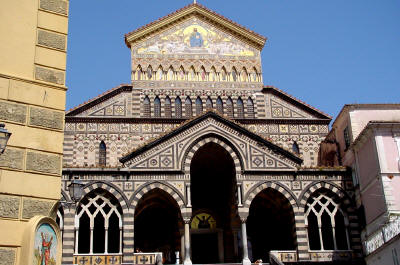
Cathedral of Amalfi (Italy)
A model Answer for
the First Quiz.
No one in the class covered all the points in this answer, but if you covered most of them you got a 10. KP
Constantine I, Emperor of the Roman Empire
He won the legendary Battle of Melvian Bridge in 312 after which he issued the Edict of Toleration (also known as the Edict of Milan) in 313, making it no longer illegal to be a Christian. This is significant because Christianity had been outlawed previously and Christians had been persecuted under the Emperors Nero and Diocletian. The Edict of Toleration allowed Christianity to be practiced freely and publicly, beginning to create the conditions for its expansion.
He erected churches. This is significant because these are the first public buildings for Christian worship
He created a second capitol for the Roman Empire
in the city of Byzantium in the East, which he renamed "Constantinople,"
and which he created as a Christian capitol. This is significant for
several reasons. First, it represents a move away from the old pagan
senatorial power of Rome and creates a locus of political power elsewhere
in the empire. Second, it locates this new center of power in the East,
where Christianity was stronger and more widespread. Third, one may draw a
connection between this new locus of power and disputes in the Church
about the role of the Bishop of Rome (the pope). Upon Constantine's moving
of the capitol, the bishop there was elevated to a patriarch, and the
increasing importance of the Patriarch of Constantinople led to disputes
over the jurisdictional role of the Bishop of Rome in the universal
Church, even though the Patriarch of Constantinople granted the pope's
honorific primacy.
He called the First Council of Nicea. This is
also significant for several reasons. First of all, it was the first
ecumenical council and inaugurated a period of ecumenical councils that
were very significant in the life of the Church in the first millennium.
Second, it addressed doctrinal and disciplinary issues that were important
for the Church at that time, specifically concerning the Arian heresy and
regulations applicable to the clergy. Third, it promulgated the Nicene
Creed, which formed the basis for the creed still used today in Christian
Churches. Fourth, it witnessed to the growing distance between East and
West insofar as it was located in the East and Pope Sylvester was absent.
Fifth, it illustrated the concept of caesaropapism, insofar as the secular
ruler exercised authority in ecclesiastical affairs.
Key:
Check mark: Good point
"X" : Incorrect point
Squiggly line: Dubious or unclear point